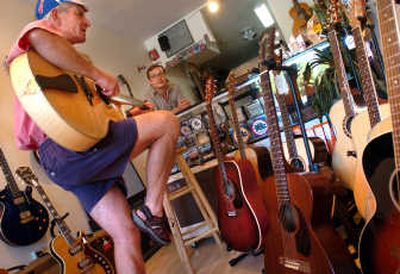How to make Garland sparkle

Garland Business District owners say they want to seize momentum from strengthening retail trade in recent years and make the district an even more attractive place to shop, dine and have fun.
They are working with City Hall and potentially with business educators from Eastern Washington University to promote the north Spokane district as a neighborhood gathering place with a strong arts and entertainment flavor.
They say they need to draw in more cafes and evening entertainment and establish promotional themes to create greater cohesiveness in the district.
One idea is to build on the district’s historic buildings including the Milk Bottle, Garland Theater, Brown Derby Tavern and Ferguson’s Cafe, all of which still have their original neon signs.
Other businesses may be encouraged to use neon on their signs to create a themed look that would distinguish the Garland district from other older commercial areas seeking greater vitality.
“We’ve got a thriving business area here that just needs a little help,” said Sue Bradley, owner of Tinman Artworks, 811 W. Garland Ave.
A major goal is to attract more arts-and-crafts people who would live and work in the district. Garland has any number of possible studio sites, and property values are considered favorable compared with the escalating values downtown.
“Our costs are a quarter of what they are downtown,” Bradley said.
Marketing data recently obtained by the city show that the Garland district has a favorable balance of businesses to nearby residents, so the district could count on more customers if businesses were offering more goods and services.
The Garland Business District, with its 87 businesses, has retail sales of $44 million a year, but residents within a half-mile radius have potential purchasing power of $69 million.
Bradley said she opened her bookstore and gallery more than four years ago. At the time, there were six commercial vacancies in her block alone. Today, however, the district has no commercial vacancies, and businesses reportedly are doing well.
To better position the business district to take advantage of area residents’ purchasing power, business owners, property owners and residents are working with City Hall on proposed changes in land-use and zoning laws for the district. They are fine-tuning the city’s “growth management” approach to land use, which emphasizes clusters of businesses and residences in a series of centers and arterial corridors.
Creating vibrant neighborhood business districts is considered a good way to reduce reliance on the automobile and to help increase the city’s tax base.
In the Garland district, business owners are pushing for a land-use designation that won’t allow more drive-up windows or light-industrial uses.
“We’re trying to make it pedestrian-friendly,” Bradley said.
At the same time, business and property owners are forming a business association, a nonprofit organization to be called Garland Business District. Forming the nonprofit organization will allow the district to apply for economic development grants, Bradley said.
Work on a business development plan is expected this fall.
“My vision is to improve the neighborhood by creating more investment,” said Bonnie Quinn, owner of Quinn Group, an advertising agency at 727 W. Garland Ave.
Quinn, who has worked at the agency for 13 years, said merchants along Garland Avenue had not been as active in the past but are starting to work together in a more committed way.
“There’s finally some synergy here,” she said.
The Garland district could become a regional attraction if it capitalizes on its assets, especially its historic buildings, Quinn said.
“There’s some nice history here,” she said, adding that the Garland Theater always has brought some “magic” to the area.
The annual Garland Street Fair is credited with helping bring new energy to the district, drawing 10,000 people last year, Quinn said.
The fifth-annual street fair will be held this year on Aug. 11 from 10 a.m. to 8 p.m.
EWU professor Robert Schwartz, whose expertise is in entrepreneurship, said the key to success is building on the foundation of favorable planning and zoning laws for the district.
“One of the challenges of urban planning is going to the next step,” he said.
Drawing in specialty stores is a key, Schwartz said, and the Garland district has any number of unusual shops. The district includes bakeries, two guitar shops, a violin shop, an improvisational theater, a dance studio and boutiques selling items such as soy candles and original bead jewelry.
Schwartz said he will offer business educational opportunities as part of EWU’s mission of being a regional resource.
Terri Cameron Stripes, program manager of Spokane’s Neighborhood Business Centers program, is working with the owners to help them come up with plans for how the Garland Business District should look and what types of businesses it should seek to add to its mix of shops.
She says business owners have been “working very hard to improve their district.”